
* Before World War II, the Imperial Japanese Navy (IJN) acquired an elegant twin-engine bomber, the Mitsubishi "G3M", which was built in large quantities. It was obsolescent by the beginning of the Pacific War in late 1941, but by that time it had been followed in service by the much improved Mitsubishi "G4M". The G4M remained an important IJN asset through the war -- though in time its lack of armor protection rendered it extremely vulnerable to Allied fighters. This document provides a history and description of Mitsubishi G3M and G4M.
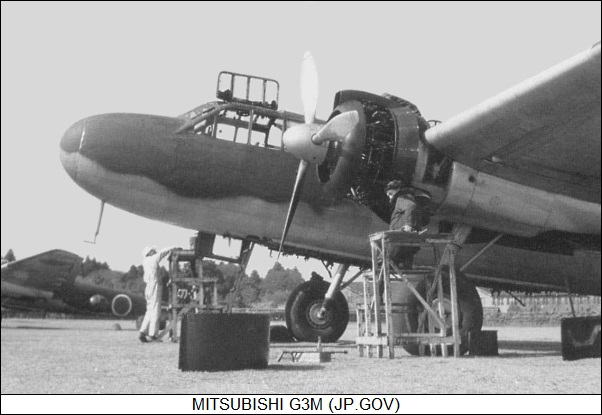
* In 1933 Admiral Yamamoto Isoroku, then chief of the Technical Division of the Bureau of Aeronautics for the Imperial Japanese Navy, sold the Naval Staff on the development of a long-range land-based aircraft to supplement naval carrier assets. A specification was then issued to Mitsubishi to develop a land-based, twin-engine reconnaissance aircraft; the details of the specification were loose, with the aircraft generally being seen as a "demonstrator" for an operational machine.
A team under Honjo Sueo went to work on the design, which was given the company designation of "Ka-9". As it emerged, the Ka-9 was a very clean and pretty machine, highly streamlined, with twin tailfins, a mid-mounted wing with a Junkers-style wedge / "double wing" configuration, twin Hiro Type 91 twelve-cylinder vee liquid-cooled engines providing 375 kW (500 HP) each, and retractable taildragger undercarriage. First flight was in April 1934, with test pilot Kojima Yoshitaka at the controls. Trials demonstrated that the machine handled beautifully, and that it had a maximum range of 6,050 kilometers (3,760 miles).
* The IJN was suitably impressed and quickly issued a new specification for a bomber based on the Ka-9, specifying a warload of 800 kilograms (1,765 pounds) and defensive armament of three 7.7-millimeter machine guns. The Ka-9 design was reworked with a heftier fuselage to handle the warload and accommodate three retractable turrets, with a single 7.7-millimeter Type 92 machine gun in each, resulting in the "Ka-15". The Ka-15 also featured bigger tailfins, more robust landing gear to handle greater weights, and other relatively minor changes. The Nakajima company tried to promote a competitive design, the "LB-2", but the IJN was not interested and moved ahead aggressively with the Ka-15.
Initial flight of the first Ka-15 prototype was in July 1935, with Kojima again at the controls, assisted by Lieutenant Sada of the IJN. The machine was powered by twin Hiro Type 91 engines, uprated to 560 kW (750 HP), driving four-bladed fixed-pitch wooden propellers. The nose was not glazed, with the bombardier sighting through a flat panel under the cockpit. The aircraft was all that was hoped for, and over the next year 20 more prototypes were built in a range of configurations:
Trials proving successful, the Ka-15 was ordered into production as the "Navy Type 96 Attack Bomber Model 11" or "G3M1" in June 1936.
BACK_TO_TOP* The G3M1 was similar to Ka-15 prototype 4, with the solid nose and Kinsei 3 radials, but differed in using four-bladed wooden propellers -- the Hamilton Standard propellers being in short supply at the time -- plus a revised canopy and a number of internal changes. There were two dorsal turrets and a single ventral turret, all retractable. The tailwheel was fixed, with the main gear retracting backwards into the engine nacelles, the wheels being left partly exposed after retraction. The G3M1 didn't have a bomb bay, all warload being carried externally on the fuselage centerline. Maximum warload was 800 kilograms (1,765 pounds), consisting of a single torpedo or one or more bombs. Performance was very good by the standards of the time, and handling was excellent; the IJN felt, with good reason, that the G3M1 was a match or better for contemporary twin-engine bombers built elsewhere.
Only 34 G3M1s were built, with production moving on to the improved "G3M2 Model 21" variant. It was much like the G3M1, the primary difference being that it featured uprated Kinsei 41 or 42 radials, providing 800 kW (1,075 HP) takeoff power, and was fitted with the Hamilton Standard three-bladed variable propellers. The fuel load was increased from 3,085 liters (814 US gallons) to 3,874 liters (1,022 US gallons); defensive armament remained the same, but different dorsal turrets were fitted.
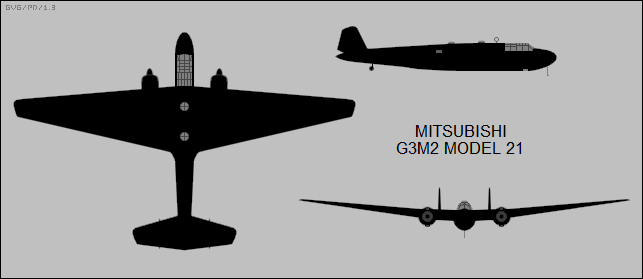
Mitsubishi built a total of 343 G3M2 Model 21 bombers in 1937 and 1938. The next variant was the "G3M2 Model 22", the major change being a rethinking of the armament scheme, which had proven inadequate in combat. The rear top turret was replaced with a new "turtle back" blister, fitted with a single Type 99 Model 1 20-millimeter cannon on a flexible mount; the ventral turret, which had proven so "draggy" that nobody wanted to actually extend it, was eliminated, replaced by a glass blister fitted to each side of the rear fuselage. Each blister was fitted with a single 7.7-millimeter gun on a flexible mount, with the blisters "staggered" to give the gunners room to move. The forward retractable turret was retained. Sources claim that late-production machines could be fitted with a single 7.7-millimeter gun in the cockpit, though details are unclear.
Other improvements included a license-built Sperry autopilot and a radio direction finder unit; they had actually been fitted to some Model 21s but were adopted as standard in the Model 22, and assisted in performing long-range flights over ocean spaces. Mitsubishi built a total of 238 G3M2 Model 22 bombers from 1939 to 1941, with late production featuring Kinsei 45 engines providing better high-altitude performance. These aircraft were the last G3Ms built by Mitsubishi, the company then moving production to the more advanced G4M, described later.
___________________________________________________________________
MITSUBISHI G3M2 MODEL 22:
___________________________________________________________________
wingspan:
25 meters (82 feet)
wing area:
75 sq_meters (807 sq_feet)
length:
16.45 meters (54 feet)
height:
3.685 meters (12 feet 1 inch)
empty weight:
4,965 kilograms (10,935 pounds)
normal loaded weight:
8,000 kilograms (17,640 pounds)
max speed at altitude:
370 KPH (230 MPH / 200 KT)
service ceiling:
9,130 meters (29,950 feet)
range:
4,380 kilometers (2,720 MI / 2,365 NMI)
___________________________________________________________________
Nakajima also built the G3M2 Model 22 under license, and in 1941 that company introduced the last G3M production variant, the "G3M3 Model 23". It was externally all but identical to the G3M2 Model 22, but was fitted with uprated Kinsei 51 engines, providing 970 kW (1,300 HP), and fuel was increased to 5,182 liters (1,367 US gallons), stretching range to an impressive 6,220 kilometers (3,365 NMI). Nakajima produced a total of 412 G3M2 Model 22 and G3M3 Model 23 bombers from 1941 to 1943 -- for a total production by Mitsubishi and Nakajima of 1,049 machines, including prototypes.
* The G3M was in combat very soon after its introduction to service. On 14 August 1937, days after fighting in China flared up again, G3M2 Model 21s were sent on bombing raids from Taipei in Formosa (now Taiwan) against targets in the Hangchow and Kwangteh regions of China. It was the first trans-oceanic raid in aviation history, with G3M2s flying from Kyushu, the southernmost of the four main Japanese islands, performing strikes against China the next day. The missions were unescorted and suffered excessive losses, the lack of self-sealing fuel tanks ensuring that the G3M tended to catch fire easily, and the weak defensive armament proving ineffective -- pushing development of the G3M2 Model 22 with its heavier armament. G3Ms were then moved to the Chinese mainland, with 130 in service there by 1940.
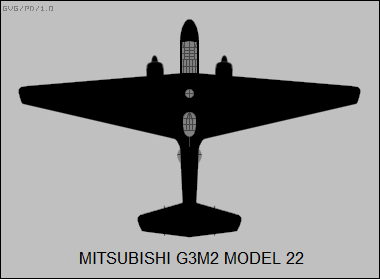
During 1941, the prospect of war with the Americans and their allies began to seem increasingly likely, and in the spring of that year the IJN formed up a special unit, equipped with G3M2s modified with a camera in the belly, to perform covert reconnaissance missions over the Philippines, Guam, and New Britain. The aircraft were painted light gray-blue overall; they lacked national insignia and any other identification markings. Mission accomplished, the special unit was disbanded in the summer of 1941.
By the outbreak of the Pacific War in December 1941, the IJN had 204 G3Ms in first-line service, with many of these machines bombing US forces at Wake Island, the Marianas, and the Philippines. The zenith of the G3M's combat history was on 10 December 1941, when a British naval task force built around the battleships HMS REPULSE and HMS PRINCE OF WALES was attacked by a flight of 60 G3Ms and 26 G4Ms in the seas near Malaya. Lacking fighter cover, the two battleships went to the bottom, taking the task force commander, Admiral Sir Tom Philips, and about a thousand sailors with them. It was a staggering disaster for the British, since it left no other major naval assets in the region to confront IJN fleet forces. It is said that many of the aircrews conducting the attack wept: the Imperial Japanese Navy was based on the British Royal Navy, even retaining many Royal Navy customs, and it was like attacking a parent.
* By that time, however, the G3M was being increasingly replaced in firstline service by the G4M, with the G3M relegated to use as a bomber trainer; glider tug -- a somewhat futile exercise, since the Japanese made little or no combat use of gliders; and as a maritime patrol aircraft, fitted with longwave search radar.
BACK_TO_TOP* The G3M was quickly obsolete as a bomber, but it remained in service as a transport to the end of the war. It had actually been used as a transport as far back as 1938, when the Dai Nippon Koku KK (Greater Japan Air Lines) obtained about two dozen G3M2s -- presumably the relatively outdated Model 21 machines -- converted to a "Mitsubishi Twin-Engine Transport" configuration. All armament was removed, to be replaced by seating for eight passengers, a passenger door on the left, and rows of windows.
The Twin-Engine Transports were given elegant names, usually after winds ("kaze"), such as "Matsukaze (Pine Wind)". They were generally used by Japan Air Lines for flights around the East Pacific region, but a few performed long-distance "show the flag" flights, including a round-the-world flight of an aircraft named simply "Nippon", sponsored by the newspaper MAINICHI SHINBUN (DAILY NEWS), that took place in installments from 26 August to 20 October 1939.
During the war, a number of G3M1s and G3M2 Model 22s were converted to a similar military passenger transport configuration by the First Naval Air Arsenal at Kasumigaura, with these machines designated "L3Y1 Model 11" and "L3Y2 Model 22" respectively. All armament was deleted except for the forward turret. At the end of the war, G3M transports were used in "surrender flights", being painted white with green crosses, and were then generally scrapped. It is unclear if any G3M bombers or transports survive.
* A total of 1,049 G3Ms was built. The following list gives G3M variants and production:
* The G3M having proven satisfactory to the IJN, in September 1937 a requirement designated as "12-Shi" was issued for an improved successor. The specification dictated a land-based bomber with a top speed of 400 KPH (215 KT), a range without bombload of 4,810 kilometers (2,600 NMI), and a range with an 800-kilogram (1,765-pound) torpedo or other warload of 3,700 kilometers (2,000 NMI). It was to be powered by twin engines in the 750 kW (1,000 HP) class.
A Mitsubishi team under Honjou Kiro set to work on the requirements. The design team found that more engine power would be required to meet the IJN specifications, and the conclusion was to use the new Mitsubishi Kasei radial providing about 1,120 kW (1,500 HP). The design that emerged featured:
The 800-kilogram warload was to be carried in an internal bomb bay -- but oddly, the bomb bay doors couldn't be opened in flight. For a combat mission, the doors were removed by the ground crew.
A full-scale mockup was available for inspection by IJN officials in the summer of 1938, but work on a flight prototype was delayed because Mitsubishi was also developing the A6M "Zero" fighter at the time. The initial prototype of the "G4M1", as it had been designated, was finally rolled out in September 1939, fitted with Kasei 11 14-cylinder two-row radials providing 1,140 kW (1,530 HP) each. Initial flight was on 23 October 1939, with test pilot Shima Katsuzo at the controls. Service trials began in January 1940, with a second prototype -- featuring a taller tailfin -- joining the trials program the next month. The G4M1 proved more than satisfactory, well exceeding requirements, with a top speed of 445 KPH (240 KT) and a range of 5,550 kilometers (3,000 NMI).
* Given the excellent performance of the G4M1, it might be thought that IJN brass would be in a hurry to put it into production, but then the program went off on a perverse tangent. The long-range G3M had suffered at the hands of Chinese fighters since no Japanese fighters were available with adequate range to provide escort, and so an effort was made to modify the G4M1 into an "escort fighter", the "G6M1". This variant featured a ventral tub in place of the bomb bay, with a 20-millimeter cannon mounted fore and aft in the tub. A single 20-millimeter cannon was mounted in the fuselage, where it could pivot to cover either side, with the G4M1's tail-mounted 20-millimeter cannon and nose-mounted machine gun retained. Provisions were made for a substantial amount of extra ammunition.
30 G6M1s -- or "Navy Type 1 Escort Fighters" as they were also designated -- were built in 1940. However, the G6M1 was too heavy, and once the G3Ms that the G6M1s were supposed to protect had dumped their bombloads, the G6M1s couldn't keep up. (The US Army Air Forces -- USAAF -- tried the same trick a few years later, modifying Boeing B-17 Flying Fortresses to the heavily armed "YB-40" configuration, with precisely the same results.) The G6M1s ended up being converted to crew trainers, to be designated "G6M1-K" or "Navy Type 1 Large Land Trainer"; later on, they were converted again to paratroop transports and designated "G6M-L2" or "Navy Type 1 Transport".
The idea of using the G6M1 as a fighter not having panned out, the type went into production in 1940 as the "Navy Type 1 Attack Bomber Model 11". Thirteen service evaluation machines were built, followed by the first production machine in April 1941, with the G4M1 in combat over China by the summer of that year.
BACK_TO_TOP* By late 1941, the Imperial Japanese government had decided on war with America and its European Allies, the primary objective being to seize the oil fields of the Dutch East Indies. 27 G4M1s were transferred to French Indochina -- which had been occupied by Japan after the fall of France to the Germans in the spring of 1940 -- in preparation for the beginning of war.
Following the surprise attack by the IJN on the US Navy base at Pearl Harbor in Hawaii on the morning of 7 December 1941 -- planned by Yamamoto Isoroku as head of the IJN Combined Fleet -- the G4M provided excellent service in the Imperial Japanese blitz over the Pacific, helping sink the HMS REPULSE and PRINCE OF WALES on 10 December (as mentioned), bombing American military installations in the Philippines, and supporting the conquest of the Dutch East Indies. The Allies became painfully familiar with the G4M.
The G4M1 was well-liked by its crews, since it had excellent range and performance, as well as very pleasant handling. They called it the "Hamaki (Cigar)" for the shape of its fuselage. However, by the spring of 1942, the lethal weakness of the type was becoming apparent: it obtained its range and power by dispensing with armor and self-sealing tanks. The lack of protection hadn't made too much difference in the early days of the war, since enemy resistance to Japanese attacks had been confused and weak. The resistance didn't stay weak indefinitely, and in attacks against northern Australia, the G4M suffered badly. It would torch up so easily that both sides would nickname it the "flying lighter".
* As a partial fix, Mitsubishi came up with an improved "G4M1 Model 12" with rubber sheeting and sponge protection for the fuel tanks, as well as a carbon-dioxide fire-extinguishing system for the fuel system. The side blister positions were eliminated in favor of less draggy flush panels, while the tail turret position was modified. However, despite fit of uprated Kasei 15 engines, the G4M1 Model 12's speed and range marginally decreased.
Survivability was improved, though the type was still essentially a deathtrap when confronted with fighter opposition. As evidence, when Admiral Yamamoto conducted a tour of the Solomons combat area, American codebreakers managed to determine his schedule, and dispatched a flight of Lockheed P-38 Lightning fighters to intercept him on 18 April 1943 as he flew into the island of Bougainville. The Lightnings arrived precisely on time to shoot down the two G4M1 Model 12s carrying Yamamoto and his staff.

* In July 1943, the substantially improved "G4M2" or "Navy Type 1 Attack Bomber Model 22" went into production. This variant featured:
Real bomb bay doors that could be opened in flight were added after initial production.
___________________________________________________________________
MITSUBISHI G4M2 MODEL 22:
___________________________________________________________________
wingspan:
25 meters (82 feet)
wing area:
78.125 sq_meters (841 sq_feet)
length:
20 meters (65 feet 7 inches)
height:
6 meters (19 feet 8 inches)
empty weight:
8,160 kilograms (17,990 pounds)
normal loaded weight:
12,500 kilograms (27,558 pounds)
max speed at altitude:
438 KPH (272 MPH / 236 KT)
service ceiling:
8,950 meters (29,935 feet)
range:
6,062 kilometers (3,765 MI / 3,270 NMI)
___________________________________________________________________
The G4M1 continued to be built in parallel until January 1944, when the supply of Kasei 21 engines permitted production to be completely shifted over to the G4M2. A total of about 1,200 G4M1s was built in all.
* Following initial deliveries of the G4M2 Model 22, production then included the "Model 22A", in which the 7.7-millimeter machine gun mounted on each side of the fuselage was replaced by a Type 99 Model 1 20-millimeter cannon, raising the number of cannon to four; and then by the "Model 22B", which featured Type 99 Model 2 cannon.
The G4M2 Model 22 series was supposed to be the end of the road for the G4M, but development of intended replacements was not going well, and so the G4M kept on being built. After delivery of 350 of all subvariants of the Model 22, production moved on to the "G4M2a", the main changes being MK4T Kasei 25 engines providing 1,380 kW (1,850 HP) and improved fuel consumption, as well as bulged bomb bay doors. Four subvariants of the G4M2a were built:
The Model 24B and Model 24C were the primary production variants. There were also a number of engine test conversions of prototypes, including the single "G4M2b Model 25" and the two "G4M2c Model 26" machines. The most notorious G4M2 conversion was the "G4M2e Model 24J", a conversion of G4M2a Model 24B and 24C machines to carry the MXY7 Oka suicide flying bomb, of which more is said below.
* The G4M2 series started to go into frontline service in the summer of 1943, with the older G4M1s reassigned to training, transport, and maritime patrol service. The G4M2 proved no match for Allied airpower during the battles of 1944, being shot down in excessive numbers, but for lack of a more adequate machine, the IJN had to keep on flying it.
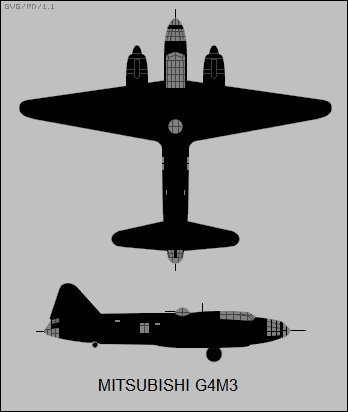
Work on a "G4M3 Model 34" variant intended to reduce the aircraft's terrible vulnerability had begun in November 1942, with this type featuring much more acceptable armor protection and self-sealing tanks, at the expense of range and performance. The G4M3 Model 34 also featured a tail turret resembling that used on the US Martin B-26 Marauder; the new turret made the fuselage shorter, resulting in changes in trim that required the tailplane to be given dihedral, instead of being flat as it was in earlier G4M variants.
Three G4M3 prototypes were built, the first flying in early 1944, with the type going into limited production in October of that year. A "G4M3a Model 34" for transport and maritime patrol was considered but not built, and two production G4M3s were modified with turbocharged Kasei engines as prototypes for a "G4M3 Model 36" that was never built.
The G4M2 remained in production in parallel with the G4M3 up to the end of the Pacific War in August 1945. By that time, a total of about 1,154 G4M2s and 60 G4M3s, including prototypes, had been built. On 19 August, four G4M1s, painted white with green crosses as surrender flight machines, arrived on Ie Shima island, carrying a delegation to discuss the details of surrender and military occupation. It is unclear how many G4Ms survive.
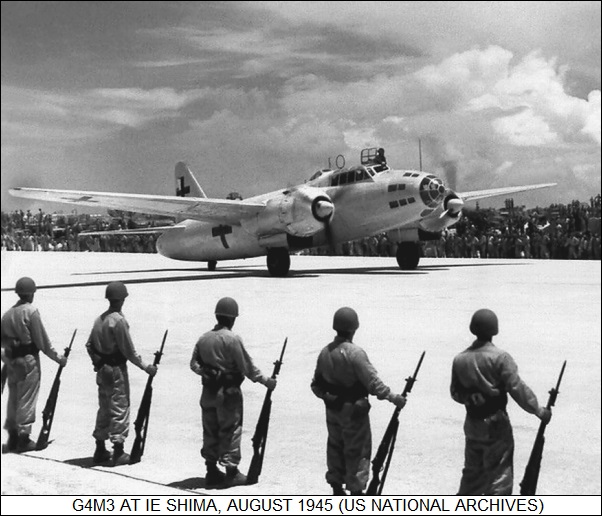
A total of 2,444 G4Ms was built in all, including 30 "G6M1" escort fighters; 1,200 "G4M1" initial production bombers; 1,154 "G4M2" bombers with improved engines and armament, plus various tweaks; and 60 "G4M3" bombers with armor and self-sealing tanks.
BACK_TO_TOP* The "Oka" suicide flying bomb, mentioned above, is one of the interesting footnotes to the G4M story and worth discussing here.
By the summer of 1944, the war was clearly going against Japan, and in desperation the Japanese military began to adopt extreme tactics, beginning with missions offering those involved little chance of survival, and then moving on to deliberately suicidal tactics. While some of the suicide tactics were dismal failures, such as the kaiten suicide mini-submarines and explosive-laden power boats, the aerial suicide corps would prove very effective in causing tremendous damage to Allied ships. The suicide pilots became known as the "kamikaze (divine wind)", after a great storm that had saved Japan from Mongol invasion centuries before.
That summer, Ensign Ota Shoichi of the IJN proposed a suicide aircraft in the form of a rocket-boosted glider that would be launched by a twin-engine bomber. Ota worked with the aeronautical engineering staff of Tokyo Imperial University to come up with a design, which he then submitted to his superiors. Although some Japanese military commanders were appalled at the idea of ordering their men on suicide missions, Ota's idea was approved. The engineering staff at the Yokosuka Naval Aeronautical Research Laboratory worked to convert the proposal into a flying design, implementing an aircraft that was to be easily flown by a poorly-trained pilot, as well as simple and cheap to build.
The program was assigned the designation the "Navy Suicide Attacker Model 11". Initial test examples were available by the end of September 1944. They were originally designated the "MXY7", but this was quickly replaced by the simple and romantic name of "Oka" -- the fleeting nature of cherry blossoms suggesting the fate of those who piloted it.
The Oka weighed 2,140 kilograms (4,718 pounds), including a huge 1,200-kilogram (2,646-pound) steel-jacketed armor-piercing warhead. The weapon was 6.07 meters (19 feet 11 inches) long, with small wings only 5.13 meters (16 feet 10 inches) long. Since the Oka was not designed to take off under its own power, a larger wing was not needed. The bomb had a twin-fin tail assembly, and three solid rockets that could be fired by the pilot singly or in combination to provide boosts during the fall to the target to evade Allied fighters or perform the terminal attack; unpowered, it had a minimum glide slope of about 5.5 degrees.

The pilot armed the weapon after launch by pulling a handle, which activated five detonators, one in the nose of the warhead and four on the rear. Fuzing could be set for instantaneous detonation, or a delay of up to 1.5 seconds to allow the warhead to penetrate into the bowels of a ship before exploding. The cockpit included armor protection to allow the pilot to press his attack to impact in the face of antiaircraft fire.
For flight training, a glider version was built, using water ballast to simulate the weight of the warhead and rockets. When the trainee completed the training portion of the flight, he would dump the ballast, allowing the lightened glider to land safely on a skid. At first, the trainer was a single-seat aircraft, but a tandem-seat version, with separate cockpits for instructor and trainee, was planned, with the designation of "Model 43 K-1 Kai".
Even as the ten test items were being delivered, the IJN was ordering the Oka into production. A decision was made to have it manufactured at the Yokosuka Arsenal to help keep the weapon secret. Some officials also believed that civilian manufacturing firms would find the idea so shocking that they would think the Navy had gone mad -- despite stereotypes of Japanese culture in the West, the notion of kamikaze tactics wasn't something that all or possibly even most Japanese accepted as rational. A force of volunteers, designated the "Jinrai Butai (Thunder God Corps)", was organized to fly the weapons. The volunteers were screened to weed out first sons of families, only children, or men with family responsibilities. The "winners" of the selection process were then put through indoctrination and training.
The training and flight tests were conducted through the fall and into the early winter of 1944. However, deployment proved troublesome. Two batches of Okas were sent to the Philippines on carriers late in 1944, but both carriers were sunk by American submarines, along with their suicide weapons. A few Okas were eventually transported to Formosa, Okinawa, Singapore, and elsewhere in the shrinking Japanese empire.
The delays in putting the Okas into operation led to demoralization of the pilots of the Jinrai Butai, since it left them with far too much time on their hands to contemplate death. One thing that was unsettling on contemplation was the delivery system. Conversions of G4Ms to the G4M2e Model 24J carrier aircraft involved removing the bomb bay doors and adding shackles for the Oka. While the Oka was likely to be all but unstoppable once released, it was a hefty load for a G4M to haul, making the vulnerable G4M even more vulnerable. Since the bombers had to fly at altitude to launch the Okas, they would certainly be picked up by American radar and torn to pieces by American fighters. The pilots of the Jinrai Butai knew they were going to die, but they at least wanted their deaths to pay off.
The Okas finally went into service on 21 March 1945, in an attempt to attack a US Navy fleet that had been raiding the Japanese home islands. A formation of 15 G4Ms and their escorting Zero fighters were simply slaughtered by US Navy Grumman Hellcat fighters. Only a few Zeroes made it back to base to report on the disaster. US Navy pilots reported that some of the bombers they shot down seemed to be carrying some kind of winged missile.
The Okas were sent into action again when the Americans invaded Okinawa at the beginning of April. This time, the G4Ms were sent in one at a time, in unpredictable directions, and they were able to release Okas. One scored a hit on one of the main turrets of the battleship USS WEST VIRGINIA.
Allied intelligence began to understand what the Japanese were up to. They called the Oka the "Baka", Japanese for "fool", trying to make a joke of it, but that was just rear-area posturing; US Navy sailors found nothing humorous about enemies who were willing to kill themselves as long as they could take some Americans with them. However, the Oka proved to rank relatively low on their list of worries. Conventional kamikaze aircraft proved far more effective than the rocket bomb, the extreme vulnerability of the G4Ms that launched the Okas making the weapon almost more damaging to the Japanese than the Americans. While Oka attacks were performed up to the end of June, the last hit they scored was on 11 May. The mother ships failed to return from their missions about 70% of the time.
The Japanese developed an improved Oka, the "Model 22", which was about a third lighter and powered by the Tsu-11 "turbo-piston" engine -- a dubious contraption featuring a compressor driven by a four-cylinder piston engine. Most of the major combatants in the war tinkered with such piston-jet hybrids, and none of them went anywhere with the concept.
In any case, the smaller Model 22 Oka was to be carried by the Yokosuka P1Y twin-engine bomber, which was much less vulnerable than the G4M and could fly higher. The Model 22 was expected to have a range of about 64 kilometers (40 miles) in operation. About 50 Model 22s were built, but none were ever used. The Japanese also considered other improved Oka versions, including one that was powered by a proper Ne-20 axial-flow turbojet derived from German BMW jet technology and catapulted from a ground launcher, but these concepts never went beyond the paper stage.
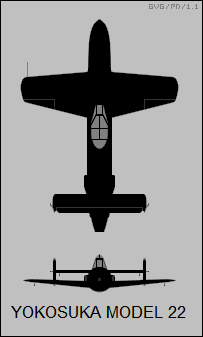
Although the kamikazes proved to be a highly effective weapon, the Oka turned out to be less a guided weapon than a misguided one. Okas were only credited with sinking one destroyer, damaging a destroyer and a minesweeper beyond repair, and repairably damaging a half-dozen other vessels. That was an insignificant score in comparison with the total earned by the kamikazes, and certainly the Okas in no way justified the resources and effort placed into them, much less the supreme sacrifices of their pilots. In the postwar period, the pilots of the Jinrai Butai who had not been committed to action and survived the war would be widely regarded as entirely cynical, mad, bad, crazy, and dangerous to know.
BACK_TO_TOP* The Allies created a codenaming system for Axis aircraft during the war, assigning names to different types. The codename for the G3M was "Nell" -- transport variants were codenamed "Tina" -- while the "G4M" was famously codenamed "Betty". However, on inspection, use of the codenames is a bit treacherous: they really weren't in widespread use until late in the war, and it's unclear they were ever universal -- German aircraft were assigned similar codenames, but they have been forgotten. Under the circumstances, it seems best to just mention that these codenames were assigned and otherwise forget about them.

* Sources include:
* Revision history:
v1.0.0 / 01 jul 07 v1.0.1 / 01 jun 09 / Review & polish. v1.0.2 / 01 apr 11 / Review & polish. v1.0.3 / 01 mar 13 / Review & polish. v2.0.0 / 01 feb 15 / Added Oka suicide flying bomb details. v2.0.1 / 01 jan 17 / Review & polish. v2.0.2 / 01 dec 18 / Review & polish. v2.0.3 / 01 oct 20 / Review & polish. v2.0.4 / 01 aug 22 / Review & polish. v2.0.5 / 01 jul 24 / Review & polish.BACK_TO_TOP
